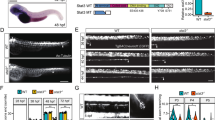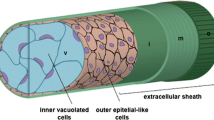Abstract
The formation of dorsal-ventral axis of the spinal cord is controlled largely by dorsal signals such as Wnts (which are members of the wingless + MMTV integrants, Int family), besides ventral signals such as sonic hedgehog (Shh). Wnt3a, one of the Wnt family members, is involved in multiple cellular functions, including self-renewal, proliferation, differentiation, and motility. Here, we aim to study the mechanism of the regulation of chicken spinal cord patterning by Wnt3a. In this study, Wnt3a was ectopically expressed in the spinal cord of developing chicken embryos by in ovo electroporation. The results of immunofluorescent staining revealed that Wnt3a ectopic expression caused the abnormality of commissural axonal projection and the formation of nerve fibers was interrupted. It is worth noting that neurons in the ventricular zone, especially motor neurons, could not migrate laterally after the Wnt3a overexpression, which led to the malformation of motor column. In addition, we found that neurons could not protrude axons outwardly after overexpression of Wnt3a in the spinal cord. It was also found that Wnt3a overexpression inhibited the outgrowth of processes in culturing SH-SY5Y cells. In conclusion, we proposed that Wnt3a regulates neuronal morphology, which subsequently disrupts axonal projection and motor neuron positioning during spinal cord development.





Similar content being viewed by others
References
Alaynick WA, Jessell TM, Pfaff SL (2011) SnapShot: spinal cord development. Cell 146(178–178):e171
Arber S, Han B, Mendelsohn M, Smith M, Jessell TM, Sockanathan S (1999) Requirement for the homeobox gene Hb9 in the consolidation of motor neuron identity. Neuron 23:659–674
Aviles EC, Wilson NH, Stoeckli ET (2013) Sonic hedgehog and Wnt: antagonists in morphogenesis but collaborators in axon guidance. Front Cell Neurosci 7:86
Avraham O, Zisman S, Hadas Y, Vald L, Klar A (2010) Deciphering axonal pathways of genetically defined groups of neurons in the chick neural tube utilizing in ovo electroporation. J Vis Exp
Du Y, Zhang S, Yu T, Du G, Zhang H, Yin Z (2016) Wnt3a is critical for endothelial progenitor cell-mediated neural stem cell proliferation and differentiation. Mol Med Rep 14:2473–2482
Golestaneh N, Beauchamp E, Fallen S, Kokkinaki M, Uren A, Dym M (2009) Wnt signaling promotes proliferation and stemness regulation of spermatogonial stem/progenitor cells. Reproduction 138:151–162
Hamburger V, Hamilton HL (1992) A series of normal stages in the development of the chick embryo. 1951. Dev Dyn 195:231–272
He S, Lu Y, Liu X, Huang X, Keller ET, Qian CN, Zhang J (2015) Wnt3a: functions and implications in cancer. Chin J Cancer 34:554–562
Heeg-Truesdell E, LaBonne C (2006) Neural induction in Xenopus requires inhibition of Wnt-beta-catenin signaling. Dev Biol 298:71–86
Imondi R, Kaprielian Z (2001) Commissural axon pathfinding on the contralateral side of the floor plate: a role for B-class ephrins in specifying the dorsoventral position of longitudinally projecting commissural axons. Development 128:4859–4871
Jessell TM (2000) Neuronal specification in the spinal cord: inductive signals and transcriptional codes. Nat Rev Genet 1:20–29
Kaprielian Z, Runko E, Imondi R (2001) Axon guidance at the midline choice point. Dev Dyn 221:154–181
Kishida S, Yamamoto H, Kikuchi A (2004) Wnt-3a and Dvl induce neurite retraction by activating Rho-associated kinase. Mol Cell Biol 24:4487–4501
Kolodkin AL, Tessier-Lavigne M (2011) Mechanisms and molecules of neuronal wiring: a primer. Cold Spring Harb Perspect Biol 3
Lin J, Fu S, Yang C, Redies C (2017) Pax3 overexpression induces cell aggregation and perturbs commissural axon projection during embryonic spinal cord development. J Comp Neurol 525:1618–1632
Lu DC, Niu T, Alaynick WA (2015) Molecular and cellular development of spinal cord locomotor circuitry. Front Mol Neurosci 8:25
Lu W, Yamamoto V, Ortega B, Baltimore D (2004) Mammalian Ryk is a Wnt coreceptor required for stimulation of neurite outgrowth. Cell 119:97–108
Luria V, Laufer E (2007) Lateral motor column axons execute a ternary trajectory choice between limb and body tissues. Neural Dev 2:13
Lyu J, Costantini F, Jho EH, Joo CK (2003) Ectopic expression of Axin blocks neuronal differentiation of embryonic carcinoma P19 cells. J Biol Chem 278:13487–13495
Megason SG, McMahon AP (2002) A mitogen gradient of dorsal midline Wnts organizes growth in the CNS. Development 129:2087–2098
Mohan R, John A (2015) Microtubule-associated proteins as direct crosslinkers of actin filaments and microtubules. IUBMB Life 67:395–403
Muroyama Y, Fujihara M, Ikeya M, Kondoh H, Takada S (2002) Wnt signaling plays an essential role in neuronal specification of the dorsal spinal cord. Genes Dev 16:548–553
Park JH, Min J, Baek SR, Kim SW, Kwon IK, Jeon SR (2013) Enhanced neuroregenerative effects by scaffold for the treatment of a rat spinal cord injury with Wnt3a-secreting fibroblasts. Acta Neurochir 155:809–816
Roelink H, Porter JA, Chiang C, Tanabe Y, Chang DT, Beachy PA, Jessell TM (1995) Floor plate and motor neuron induction by different concentrations of the amino-terminal cleavage product of sonic hedgehog autoproteolysis. Cell 81:445–455
Seo DK, Kim JH, Min J, Yoon HH, Shin ES, Kim SW, Jeon SR (2017) Enhanced axonal regeneration by transplanted Wnt3a-secreting human mesenchymal stem cells in a rat model of spinal cord injury. Acta Neurochir 159:947–957
Suh HI, Min J, Choi KH, Kim SW, Kim KS, Jeon SR (2011) Axonal regeneration effects of Wnt3a-secreting fibroblast transplantation in spinal cord-injured rats. Acta Neurochir 153:1003–1010
Surmeli G, Akay T, Ippolito GC, Tucker PW, Jessell TM (2011) Patterns of spinal sensory-motor connectivity prescribed by a dorsoventral positional template. Cell 147:653–665
Tanabe Y, Roelink H, Jessell TM (1995) Induction of motor neurons by Sonic hedgehog is independent of floor plate differentiation. Curr Biol 5:651–658
Tsuchida T, Ensini M, Morton SB, Baldassare M, Edlund T, Jessell TM, Pfaff SL (1994) Topographic organization of embryonic motor neurons defined by expression of LIM homeobox genes. Cell 79:957–970
Vijayaragavan K, Szabo E, Bosse M, Ramos-Mejia V, Moon RT, Bhatia M (2009) Noncanonical Wnt signaling orchestrates early developmental events toward hematopoietic cell fate from human embryonic stem cells. Cell Stem Cell 4:248–262
Yamada T, Pfaff SL, Edlund T, Jessell TM (1993) Control of cell pattern in the neural tube: motor neuron induction by diffusible factors from notochord and floor plate. Cell 73:673–686
Yin ZS, Zu B, Chang J, Zhang H (2008) Repair effect of Wnt3a protein on the contused adult rat spinal cord. Neurol Res 30:480–486
Zou C, Chou BK, Dowey SN, Tsang K, Huang X, Liu CF, Smith C, Yen J, Mali P, Zhang YA, Cheng L, Ye Z (2012) Efficient derivation and genetic modifications of human pluripotent stem cells on engineered human feeder cell lines. Stem Cells Dev 21:2298–2311
Funding
This work was supported by a grant from the National Science Foundation of China (No 81771226; 81600987), the Henan Province Natural Science Foundation (162300410214;), the support project for the Disciplinary Group of Psychology and Neuroscience, Xinxiang Medical University (2016PN-KFKT-03, 20172DCG-03), the Science and Technology Innovation Talents Support Program of Henan Universities and Xinxiang City (14HASTIT032, CXRC16003), Xinxiang major science and technology projects (ZD17008), the Henan Province University youth researcher support program project (2015GGJS-133), the PhD Research Startup Foundation (505090) of Xinxiang Medical University, and the Henan Key Laboratory of Medical Tissue Regeneration Open Project (KFKT15002).
Author information
Authors and Affiliations
Corresponding author
Ethics declarations
Conflict of Interest
The authors declare that they have no conflict of interest.
Rights and permissions
About this article
Cite this article
Li, Q., Yang, C., Zhang, B. et al. Wnt3a Ectopic Expression Interferes Axonal Projection and Motor Neuron Positioning During the Chicken Spinal Cord Development. J Mol Neurosci 64, 619–630 (2018). https://doi.org/10.1007/s12031-018-1060-z
Received:
Accepted:
Published:
Issue Date:
DOI: https://doi.org/10.1007/s12031-018-1060-z




